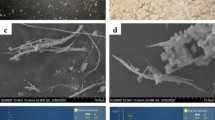Summary
Our study included 27 polyurethane foam workers exposed to MDI only at low concentrations (ranging from 0.0005 to 0.001 ppm) and 27 clerks from the same factory matched by age. Respiratory function tests were performed on a Monday and Friday of the same week at shift onset, 4 h later and at shift end. The subjects under study were asymptomatic for asthma. The two groups had quite similar spirometric values with minimal functional impairment. A statistical analysis was carried out by Student's t-test for matched pairs and two-way analysis of variance (ANOVA), in order to take into account both occupational exposure and smoking habits. No significant differences between the two groups were observed with paired t-tests in the respiratory parameter trend during both the Monday and Friday work shift. Nor were differences observed within the two groups when Friday's and Monday's results were compared. No significant differences between the two groups were found in paired comparisons between Friday and Monday for respiratory parameters. ANOVA demonstrated that the FEV1 and FEF25-75 reduction present on Friday, when compared to Monday, was related to smoking and not to occupational exposure. In conclusion our findings showed no short-term respiratory changes in subjects exposed to low MDI concentration.
Similar content being viewed by others
References
Berry G, McKerrow CB, Molyneux MKB, Rossiter CE, Tombleson JBL (1973) A study of the acute and chronic changes in ventilatory capacity of workers in Lancashire cotton mills. Br J Ind Med 30:25–36
Brochhagen FK, Schal HP (1986) Diphenylmethane diisocyanate: the concentration of its saturated vapor. Am Ind Hyg Assoc 47:225–228
Chan-Yeung M, Schulzer M, MacLean L, Dorken E, Tan F, Lam S, Enarson D, Grzybowski S (1981) A follow-up study of the grain elevator workers in the port of Vancouver. Arch Environ Health 36:75–81
Commission des Communautes Europeennes (1971) Aidememoire pour la pratique de l'examen de la function ventilatoire par la spirographie. Luxembourg
Diem JE, Jones RN, Hendrick DJ, Glindmeyer HW, Dharmarajan V, Butcher BT (1982) Five-year longitudinal study of workers employed in a new toluene diisocyanate manufacturing plant. Am Rev Respir Dis 126:420–428
Dimich HD, Sterling TD (1981) Ventilatory function changes over a workshift. Br J Ind Med 38:152–155
Enarson DA, Yeung M (1985) Determinants of changes in FEV1 over a workshift. Br J Ind Med 42:202–204
Guberan E, Williams MK, Walford J, Smith MM (1969) Circadian variation of FEV in shift workers. Br J Ind Med 26:121–125
Hankinson JL, Boehlecke B (1981) Variability of spirometric pulmonary function studies. Am Rev Respir Dis 123; Suppl 148
Hill RN (1970) A controlled study of workers handling organic diisocyanates. Proc R Soc Med 63:375–376
Holness DL, Broder I, Corey PN, Booth N, Mozzon D, Nazar MA, Guirguis S (1984) Respiratory variables and exposure-effect relationships in isocyanate-exposed workers. J Occup Med 26:449–455
Knudson RJ, Slatin RC, Lebowitz MD, Burrows B (1976) The maximal expiratory flow-volume curve. Normal standards, variability and effects of age. Am Rev Respir Dis 113:587–600
Love RG (1983) Lung function studies before and after a work shift. Br J Ind Med 40:153–159
Musk AW, Peters JM, Berstein L (1985) Absence of respiratory effects in subjects exposed to low concentrations of TDI and MDI: a reevaluation. J Occup Med 27:917–920
Musk AW, Peters JM, DiBerardinis L, Murphy RLH (1982) Absence of respiratory effects in subjects exposed to low concentrations of TDI and MDI. J Occup Med 24:746–750
Musk AW, Peters JW, Wegman DH (1988) Isocyanates and respiratory disease: current status. Am J Ind Med 13:331–349
National Institute for Occupational Safety and Health (1981) Technical report: respiratory and immunologic evaluation of isocyanate exposure in a new manufacturing plant. DHHS (NIOSH) Publication no. 81-125. Wash DC: DHHS (NIOSH)
Peters JM, Murphy RLH (1970) Pulmonary toxicity of isocyanates. Ann Int Med 73:654–655
Peters JM, Murphy RLH, Ferris BJ (1969) Ventilatory function in workers exposed to low levels of toluene diisocyanate: a six-month follow-up. Br J Ind Med. 26:115–120
Peters JM, Murphy RLH, Pagnotto LD, Van Ganse WF (1968) Acute respiratory effects in workers exposed to low levels of toluene diisocyanate (TDI). Arch Environ Health 16:642–647
Walford J, Lammers B, Schilling RSF, Van Den Hoven Van Genderen D, Van der Veen YG (1966) Diurnal variation in ventilatory capacity. An epidemiological study of cotton and other factory workers employed on shift work. Br J Ind Med 23:142–148
Wegman DH, Pagnotto LD, Fine LJ, Peters JM (1974) A dose-response relationship in TDI workers. J Occup Med 16:258–260
Author information
Authors and Affiliations
Rights and permissions
About this article
Cite this article
Sulotto, F., Romano, C., Piolatto, G. et al. Short-term respiratory changes in polyurethane foam workers exposed to low MDI concentration. Int. Arch Occup Environ Heath 62, 521–524 (1990). https://doi.org/10.1007/BF00381183
Received:
Accepted:
Issue Date:
DOI: https://doi.org/10.1007/BF00381183




